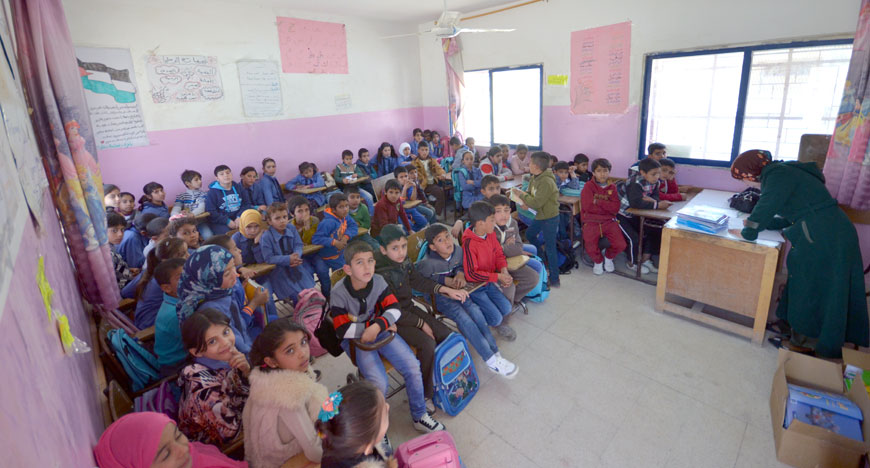AMMAN/MAFRAQ – For the past five years, Nour Shurafat, a Jordanian teacher, has faced a great difficulty in taking control of her classrooms at Asma Bint Abi Baker School in the northern village of Zaatari near Mafraq.
The influx of Syrian refugees into the Kingdom during the past period has resulted in a significant increase in the number of students Shurafat has to accommodate.
"Now, I deal with 40 students in one class consisting of both Syrians and Jordanians. In the past I used to teach around 25 students and now the number is higher, which requires more exceptional efforts to control the situation," she told The Jordan Times in a recent interview at the school.
But the number of students Shurafat is dealing with is smaller when compared to other classes at the same school.
The principal of the school, Taghrid Mashaqbeh, said a total of 570 Syrians attend classes during the afternoon shift, with an average of 70 students in one class.
"The main problem is the growing number of students and the solutions are short term. The Syrian crisis does not seem like it will end soon and we will definitely receive more students," she told The Jordan Times at her office.
The main challenge for most educators in the northern village is not only the number. Age is a bigger issue, especially in light of the coeducation systems for the first four grades.
Randa Nuaimi, the principal of Qortba School in the same area, said many Syrian boys who are aged 12 study in the same class with girls who are younger than them.
"The problem is that these children missed academic years and when they first attend school in Jordan, they attend the class they had to leave in Syria. This makes the girls uncomfortable and this is a disturbing problem," she told The Jordan Times at her office.
Most of the turnout of Syrian children seeking schooling concentrates in the northern governorates due to their proximity to home, followed by the vast North Badia, according to figures provided by the education department in the desert region.
A total of 146 schools located there are attended a total of 3,090 Jordanians and Syrians students, according to the directorate.
Of the total number of schools, three operate a double shift, attended by 1,281 students, the statistics showed.
There are also 24 schools located inside the Zaatari camp for Syrian refugees, which is also located in the governorate of Mafraq.
The figures constantly change because many Syrian families move to neighbouring cities to seek job opportunities and better living conditions.
Mashaqbeh said the rising number of students has not only forced the administrations of the schools to shorten the duration of classes, but the crowds have a negative impact on infrastructure.
“The infrastructure has been negatively affected including windows, chairs, bathrooms and other facilities and we can hardly find the funds to carry out maintenance work,” she added.
The headmistress said they try to attract international organisations to support them financially when it comes to rehabilitation, but she said they are facing difficulties to do so as most organisations prefer to focus on the capital and Zarqa.
Asma Khaldi, her assistant, said these organisations sometimes pay attention to the Syrian student, at the expense of the Jordanian peers, which makes the later a bit sensitive towards their Syrian classmates.
UNICEF Representative to Jordan Robert Jenkins said he thinks it is true that public schools have been placed under mounting pressure by the influx of Syrian refugees and the world is aware of that and is trying to help.
“It was globally recognised at the [donor] conference in London [in February]. The Ministry of Education with UNICEF and other donors are trying to ease that pressure through different means”.
These include expanding the school system by building more schools and renovating existing ones, he told The Jordan Times at UNICEF headquarters in Amman.
He noted that they are working with the ministry on the quality of education in general. “It is important for us to continue explore how the formal school system can provide other means of learning.”
During the London conference, the government announced that donors pledged $700 million a year for 2016, 2017 and 2018 to develop services and infrastructure in the fields of health, education, water and municipal services in host communities.
Donors also pledged to offer concessionary loans worth $1.9 billion a year until 2018, in addition to grants worth $900 million over three years.
They also expressed willingness to secure funds for education to 80,000 to 90,000 Syrian students at a cost of $1 billion to build more classrooms and new schools to accommodate them.
Mashaqbeh said, following the outcomes of the conference, she had a hope that many schools including hers would be expanded to put up with students.
The Ministry of Education was not available for comments on the issue despite several attempts made by The Jordan Times.
Khaldi hoped that the new schools would included facilities like theatre and labs because many public schools lack such facilities.
For Nour Shurafat, she wants some peace of mind.
